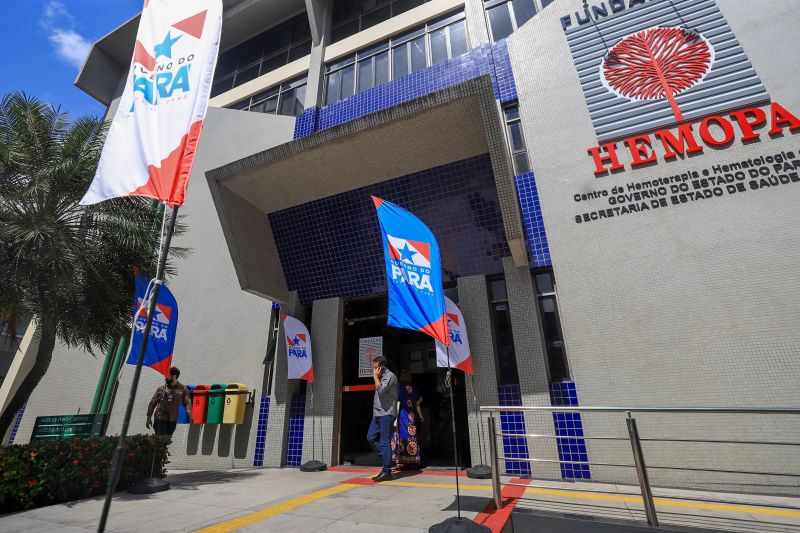Hemopa is a reference in the diagnosis and treatment of sickle cell disease in Pará
Currently, Hemocentro assists 1,150 people, mostly children and adolescents, in treatment and reinforces the importance of awareness

On World Sickle Cell Disease Awareness Day, the Pará Hemotherapy and Hematology Center Foundation (Hemopa) reinforces its role as a state reference in the diagnosis, treatment, and follow-up of people with this genetic disease, prevalent in the black population and associated with intense pain, infections, anemia, and complications in various organs.
Care begins in childhood through neonatal screening. The heel prick test, performed free of charge in the public network, allows for the early diagnosis of the disease and referral to Hemopa, where the clinical protocol indicated for these cases is initiated.
“The diagnosis is made through the heel prick test. With the result, the patient is referred to start treatment with appropriate medications to prevent possible complications,” explains hematologist Dr. Saide Sarmento Trindade, who coordinates the outpatient care of the institution.
Hemopa follows all protocols established by the Ministry of Health for the treatment of sickle cell disease. Among the measures adopted are prophylaxis with penicillin and folic acid, the use of hydroxyurea (starting at nine months of age), transcranial Doppler examination between the ages of two and 16 to prevent stroke, therapy with iron chelators in cases of overload, and chronic transfusion schemes, with monthly transfusions of filtered and phenotyped red blood cell concentrate, as clinically indicated. Care is provided by a multiprofessional and multidisciplinary team, focusing on comprehensive care.
“Hemopa is the reference service in the state for the follow-up of people with sickle cell disease. The work is done by a multiprofessional and multidisciplinary team, with appropriate guidance for families. The support from nursing, the role of psychology, social services, dentistry, physiotherapy, physical medicine, pharmaceutical assistance, and also pedagogy, which assesses the cognitive development of the child, is essential,” details the hematologist.
According to data from the Coordination of Outpatient Clinics (Coamb), about 1,150 patients with sickle cell disease are currently followed by the Hemopa Foundation, including residents of the capital and various municipalities in the interior of the state. Most of those served are children and adolescents, but the service also follows adults living with the chronic form of the disease.
In more severe cases, bone marrow transplantation is a therapeutic alternative. “Today it is possible to perform the transplant for patients who have a 100% compatible sibling, through the histocompatibility test. And we are advancing towards haploidentical transplantation, with 50% compatibility between donor and recipient,” adds Saide. Hemopa conducts clinical follow-up and referral of cases to transplant centers in other states of the country.
The institution has also invested in therapeutic innovation. In partnership with the Hospital de Clínicas da Bahia, Hemopa has already performed procedures with cell therapy aimed at treating avascular necrosis, a common orthopedic complication among people with sickle cell disease. The results indicate significant improvement in the mobility and quality of life of patients subjected to the technique.
In addition to medical assistance, Hemopa is responsible for the registration of bone marrow donors in Redome — National Registry of Bone Marrow Donors. The procedure is simple and can be done with the collection of just 10 ml of blood, contributing to the hope of curing people with sickle cell disease who are waiting for a transplant.
Patient Aline Nunes Saraiva, who has been receiving treatment since birth, highlights the importance of investments in structure and technology:
“I am a person with sickle cell anemia and have been receiving treatment since I was born. When the health service invests in equipment, it better meets our specific needs, makes procedures more effective, and facilitates adherence to treatment. Depending on the technology, it is even possible to reduce hospitalizations, avoiding more serious complications. In the long run, this represents savings for everyone — both for patients and for the health system. More than a technical advancement, it is a gain in quality of life.”
Sickle cell disease is one of the most common hereditary diseases in Brazil and directly impacts the school, professional, and family routine of patients. Therefore, specialized and continuous follow-up is essential to ensure autonomy, quality of life, and social inclusion.
In recent years, Hemopa has also been strongly working on expanding the state blood network. Six new transfusion agencies have been delivered in the municipalities of Ourilândia do Norte, Bragança, Portel, Salinópolis, Santana do Araguaia, and also in Belém, with the implementation of the ATs at the Hospital Beneficente Portuguesa and the Hospital da Mulher. In the Metropolitan Region, a new blood collection post was inaugurated at Pórtico Castanheira, with modern structure and an expectation of up to 20% increase in donations.
The president of the Hemopa Foundation, Paulo Bezerra, highlighted the institution's commitment to continuous care. “On World Sickle Cell Disease Awareness Day, the Hemopa Foundation emphasizes the importance of the work of its multiprofessional professionals, who daily accompany the treatment of registered patients. This is a permanent dedication of the institution to ensure more quality of life for the people served.”
Service - World Sickle Cell Disease Awareness Day is celebrated on June 19. At Hemopa, the commemorative program will take place on June 24, at CENTUR, from 9 am to 12 pm. Activities include visits from children to the playroom, special snacks, a performance by the Hemopa Choir, theater with students from Fibra, and a musical performance by Nilson Chaves (voice and guitar).









